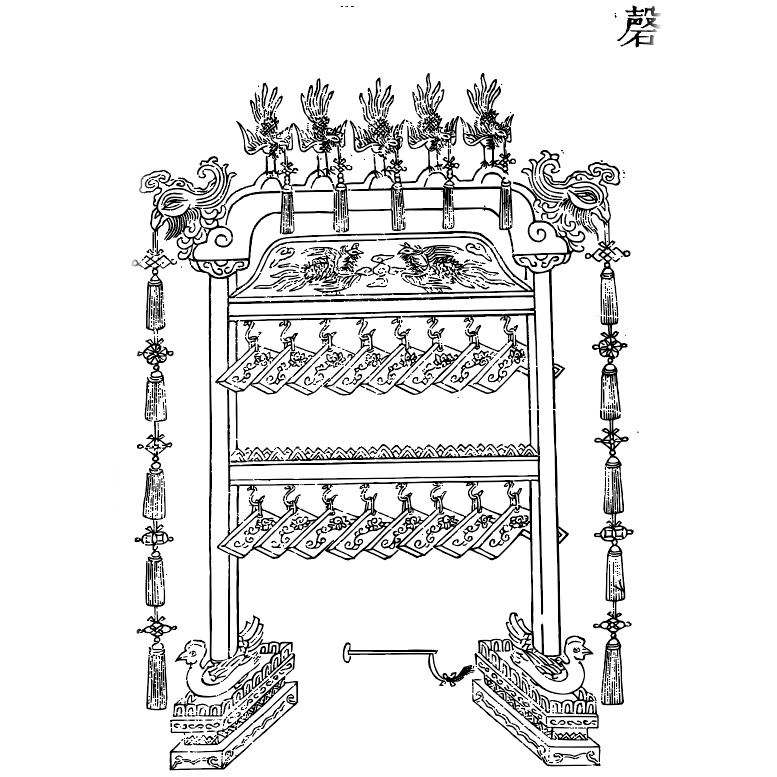bianqing overview
 Bianqing (pinyin: biān qìng) is one of the ancient percussion instruments of the Han nationality, mostly used in court music or grand ceremonies. A set of stone or jade chimes with different pitches are hung on the wooden frame, and the music is played with a small mallet.
Bianqing (pinyin: biān qìng) is one of the ancient percussion instruments of the Han nationality, mostly used in court music or grand ceremonies. A set of stone or jade chimes with different pitches are hung on the wooden frame, and the music is played with a small mallet.Sixteen "chimes" are grouped together. In addition to playing the timbres with twelve positive temperaments (Huangzhong, Dalu, Taicuo, Jiazhong, Guxi, Zhonglu, Ruibin, Linzhong, Yize, Nanlu, Wushe, Yingzhong), There are four semitones. According to legend, Confucius in the Spring and Autumn Period was a master at making chimes.
Since the 1970s, large-scale braided chimes have been unearthed in Jiangling and Sui County in Hubei successively. The ancient city of Jinan in Jiangling, Hubei, was the capital of Chu during the Spring and Autumn Period and the Warring States Period. A set of 25 chimes were unearthed here in 1970. The chime body is made of cyan limestone, with a gōu sentence shape on the upper part and a slight arc shape on the bottom. The surface has clear painted patterns and slightly concave and convex patterns. Four of them are painted with pictures of phoenix birds, with elegant colors and smooth lines.
A complete set of 41 chimes unearthed from the tomb of Marquis Yi of Zeng, Suixian County, Hubei Province, is made of stone and hung in two layers. There are 16 pieces on the upper level and 16 pieces on the lower level. The other 9 pieces can be called at any time. This set of chimes is closely related to the chimes. Together, you can perform an ensemble on the same pitch or play in transposition at the same time. Its sound effect is "closer, the bell will be bright, and far away, the chime will be loud".
In the second half of 1980, Hubei Provincial Museum and Wuhan Institute of Physics cooperated to copy this large-scale chime from the early Warring States period more than 2,400 years ago. And beautiful, with a range of three octaves, you can rotate the palace to change the tune, and play a variety of music.
The chimes made in the Qing Dynasty were mainly used for "Dan Bi Da Le" for the celebration of emperors and princes and ministers, "Zhonghe Qing Le" and "Dan Bi Qing Le" for large banquets in the palace. A set of 16 chimes made during the Qianlong period of the Qing Dynasty, with the same size and different thickness, is made of Hetian jasper in Xinjiang, whose shape is the same as the special chime, but is smaller in size. The whole set must be used every time you perform, and the chimes are struck with the melody of the music. play. In the fifty-fifth year of Qianlong's reign in the Qing Dynasty (1790), Emperor Qianlong also made a set of gold chimes with gold, and a set of gold chimes was used with it.
- Pinyin:biān qìng
- application:Royal court music or grand ceremony
- material:stone or jade
- Classification:percussion
reference materials and contributors
- 编磬 · 百度百科
- 编磬 · 搜狗百科
- 编磬 · 维基百科
- 12件双层编钟及13音编磬 · 古编钟史代
overview of other similar instruments
- sanyanxiao overview
- Daguangxian overview
- Leiqin overview
- hahao overview
- yandundagu overview
- Han Xiaozheng overview
- Fang Xiang overview
- guanzi overview
- zhuqin (Dao Qin) overview
- zhuiqin overview
- bangzi overview
- three-stringed piano overview
- Gehu overview
- xiao overview
- xiaokonghou overview
- Konghou overview
- Sheng overview
- suona overview
- hulusi overview
- gushao overview
 渝公网安备 50010702504639号
渝公网安备 50010702504639号